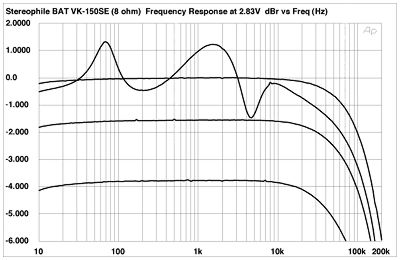| Columns Retired Columns & Blogs |
Balanced Audio Technology VK-150SE monoblock power amplifier Measurements
Sidebar 3: Measurements
The big BAT VK-150SE offered a healthy 26.6dB voltage gain into 8 ohms from its 8 ohm output-transformer tap, a rather lower 24.8dB into the same load from the 4 ohm output. The input impedance was a very high 170k ohms and the amplifier inverted absolute polarity (pin 3 of its input XLR appears to be wired "hot"). The output impedance was a moderately high 1.3 ohms from the 4 ohm tap, this increasing to 2.3 ohms from the 8 ohm tap. As a result, there was a significant ±1.2dB response variation with our simulated loudspeaker load (fig.1), resulting from the interaction between the amplifier's source impedance and the manner in which the load's impedance varied with frequency. Even from the 4 ohm output, the response variation was ±0.8dB, which will be audible.

Fig.1 Balanced Audio Technology VK-150SE, 8 ohm tap, frequency response at (from top to bottom at 2kHz): 2.83V into dummy loudspeaker load, 1W into 8 ohms, 2W into 4 ohms, 4W into 2 ohms (0.5dB/vertical div.).
However, into resistive loads, the VK-150SE's response can be seen from fig.1 to be flat across the audioband, with a well-controlled ultrasonic rolloff free from resonant peaks and reaching -3dB around 120kHz. This is a high frequency when you consider that, used as a monoblock, the amplifier has two output transformers in series with the load. The shape of a 1kHz squarewave (not shown) was essentially perfect, while that of a 10kHz wave (fig.2) revealed a short risetime and a freedom from overshoot.

Fig.2 Balanced Audio Technology VK-150SE, 8 ohm tap, small-signal 10kHz squarewave into 8 ohms.
Plotted against frequency, the level of THD+noise from the VK-150SE's 8 ohm tap remained below 0.1% at midrange and treble frequencies into a 16 ohm load, but rose progressively at low frequencies and with increasing output current (fig.3). As expected, the picture was better from the 4 ohm transformer tap (fig.4). At low currents, the distortion content was heavily second-harmonic (fig.5), but third and higher harmonics appeared with lower impedances and correspondingly higher currents (fig.6).

Fig.3 Balanced Audio Technology VK-150SE, 8 ohm tap, THD+noise (%) vs frequency at (from top to bottom at 10kHz): 4W into 2 ohms, 2W into 4 ohms, 2.83V into simulated loudspeaker load, 1W into 8 ohms, 0.5W into 16 ohms.

Fig.4 Balanced Audio Technology VK-150SE, 4 ohm tap, THD+noise (%) vs frequency at (from top to bottom at 10kHz): 4W into 2 ohms, 2W into 4 ohms, 2.83V into simulated loudspeaker load, 1W into 8 ohms, 0.5W into 16 ohms.

Fig.5 Balanced Audio Technology VK-150SE, 4 ohm tap, 1kHz waveform at 1W into 8 ohms (top), distortion and noise waveform with fundamental notched out (bottom, not to scale).

Fig.6 Balanced Audio Technology VK-150SE, 4 ohm tap, 1kHz waveform at 2W into 4 ohms (top), distortion and noise waveform with fundamental notched out (bottom, not to scale).
- Log in or register to post comments



































